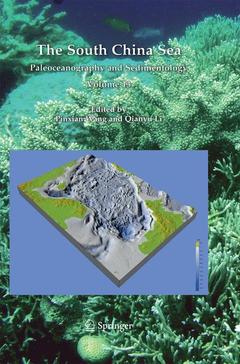Description
The South China Sea, 2009
Paleoceanography and Sedimentology
Developments in Paleoenvironmental Research Series, Vol. 13
Coordinators: Wang Pinxian, Li Qianyu
Language: English
Subjects for The South China Sea:
Keywords
Marine geology; Ocean; Oceanography; Sediment; geomorphology; marine; oceanic; sea level; hydrogeology; mineral resources
Publication date: 11-2014
506 p. · 15.5x23.5 cm · Paperback
Publication date: 05-2009
506 p. · 15.5x23.5 cm · Hardback
Description
/li>Contents
/li>Biography
/li>Comment
/li>
Pinxian Wang was born in Shanghai in 1936. He graduated from the Moscow State University in 1960, majoring in paleontology, and was Alexander von Humboldt Fellow in 1981-82 in Kiel, Germany. He is now Professor at the Tongji University, where he was Director of the Department of Marine Geology and the Laboratory of Marine Geology for years. His research activities are mainly devoted to paleoceanography and micropaleontology in the Western Pacific and paleo-monsoon studies in East Asia, especially in the South China Sea. He was co-chief scientist of the Ocean Drilling Program Leg 184 to the South China Sea in 1999 and the Marco Polo Cruise to the South China Sea in 2005. He has promoted China’s involvement in international deep-sea programs and founded the series of "Asian Marine Geology Conferences". He is Member of the Chinese Academy of Science, Honorary Fellow of the Geological Society London, AAAS Fellow,and Milutin Milankovic Medalist of EGU in 2007.

